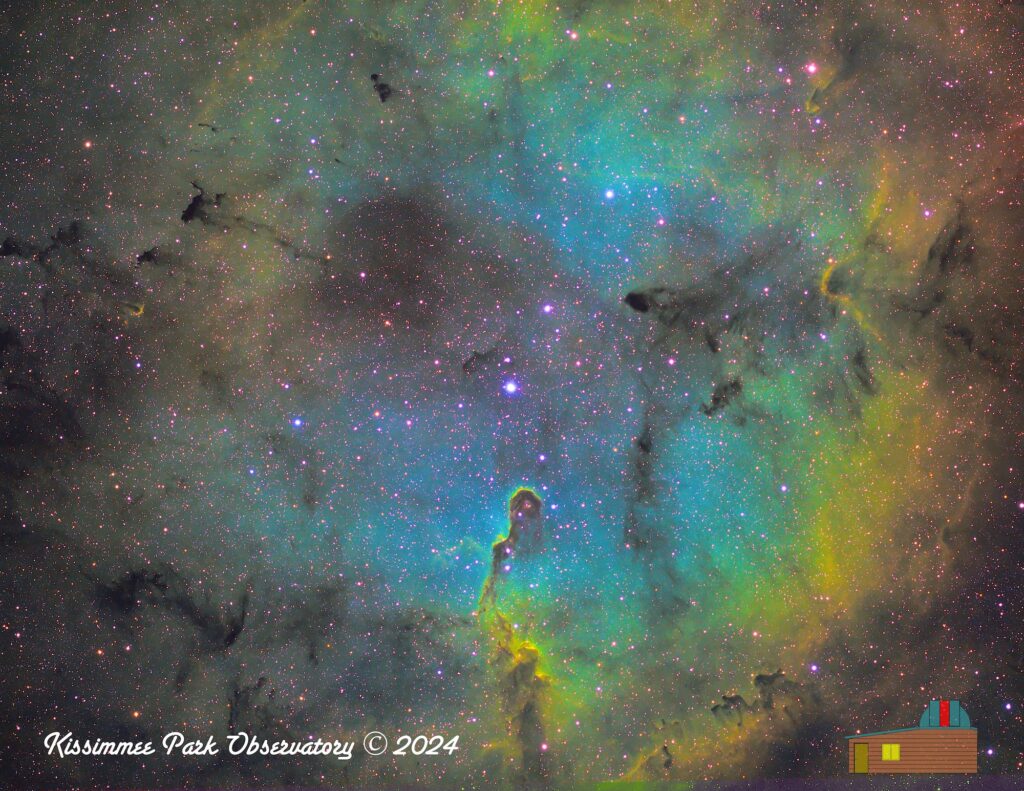
The Elephant Trunk Nebula, IC 1396, as captured by the WFAC (Askar 400). Total integrated SHO4 exposure of 5.3 hours.
Exploring the Cosmic Elephant: The Wonders of IC 1396, The Elephant Trunk Nebula
Introduction
In the vast expanse of our galaxy, there are celestial bodies and formations that capture the imagination like no other. One such marvel is IC 1396, more famously known as the Elephant Trunk Nebula. This nebula, located in the constellation of Cepheus, about 2,400 light-years from Earth, offers a spectacular view of star formation and cosmic structures.
The Formation and Structure
IC 1396 is an emission nebula illuminated by a bright central star, HD 206267, whose ultraviolet radiation ionizes the nebula’s gas, causing it to glow. However, the most striking feature of IC 1396 is its namesake, the “Elephant Trunk,” a dark, dense globule of dust and gas that resembles an elephant’s trunk due to its shape and structure.
-
The Trunk: This pillar structure is a result of the stellar winds and radiation from the central star. These forces shape the nebula, creating dense pockets where stars can form. The trunk is a prime example of how young, massive stars influence their surroundings, sculpting vast clouds of interstellar dust and gas.
-
Star Formation: Inside these dense regions, new stars are being born. The process is obscured by the dust, making it an area of interest for astronomers studying stellar nurseries. The elephant trunk itself is a stellar nursery, where the conditions are just right for the condensation of gas and dust into new stars.
Scientific Significance
-
Astronomy Insights: IC 1396 provides insights into the life cycle of stars. By studying such regions, astronomers can understand the processes of stellar birth, life, and death. The nebula’s interaction with its central star helps us comprehend how stars can drastically alter their environment.
-
Astrophotography: For astrophotographers, IC 1396 is a jewel. The contrast between the dark, dense globules and the glowing gas makes for breathtaking images. The intricate details of the trunk and surrounding nebulosity have been captured by telescopes like the Hubble Space Telescope, revealing not only the beauty but the complexity of star formation.
Visual Wonders
When viewed through different filters or by various telescopes:
-
Visible Light: The nebula appears as a reddish glow due to hydrogen-alpha emissions with dark patches where the trunk and other globules block light.
-
Infrared: Observations in infrared light reveal the hidden stars within the trunk, showcasing the young stars still embedded in their birth cloud.
Cultural and Aesthetic Appeal
Beyond its scientific value, IC 1396 stirs the imagination:
-
Mythological Connections: The nebula’s shape has been likened to various mythological creatures or objects, adding a cultural layer to its scientific exploration.
-
Artistic Inspiration: The nebula’s ethereal beauty has inspired artists and writers, becoming a symbol of the universe’s vast, mysterious artistry.
Conclusion
IC 1396, The Elephant Trunk Nebula, stands as a testament to the dynamic processes occurring within our galaxy. It’s not just a subject of study but a reminder of the universe’s ongoing creation story. As technology advances, our understanding of such nebulae deepens, but the awe they inspire remains timeless. Whether you’re an astronomer, an astrophotographer, or simply a stargazer, IC 1396 offers a glimpse into the cosmic ballet of star formation, a dance that continues to captivate all who look up.
Click on the image to view a larger version you can explore.
Image Info
- Imaged at the Chiefland Astronomy Village, Chiefland, FL (Bortle 4)
- Camera : ZWO ASI1600MM Pro
- Scope: Askar 400 Astrograph
- Mount: iOptron Smart-EQ Pro
- Hydrogen Alpha: 22 subframes of 300s = 110 min integration
- Oxygen III: 22 subframes of 300s = 110 min integration
- Sulfur: 20 subframes of 300s = 100 min integration
- Total integration time: 320min = 5.3 hours.
- Captured via ASIAir Pro automation
- Optical tracking via ASIAir automation via the ASI120MM-S guide camera
- Separate channels stacked and SHO4 integrated in Astro Pixel Processor
- Image run through Super DeNoising
- Final processing in Aperture
